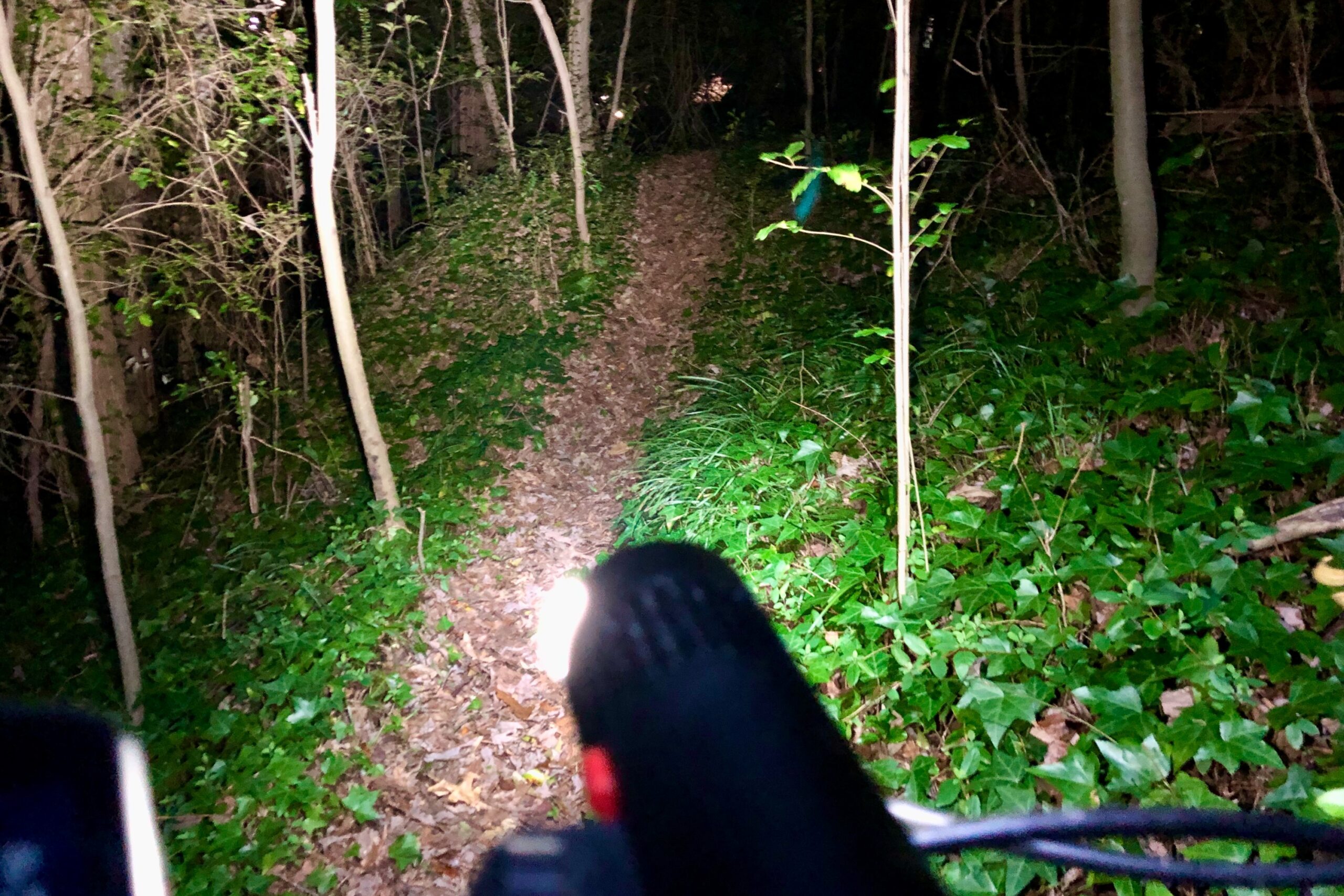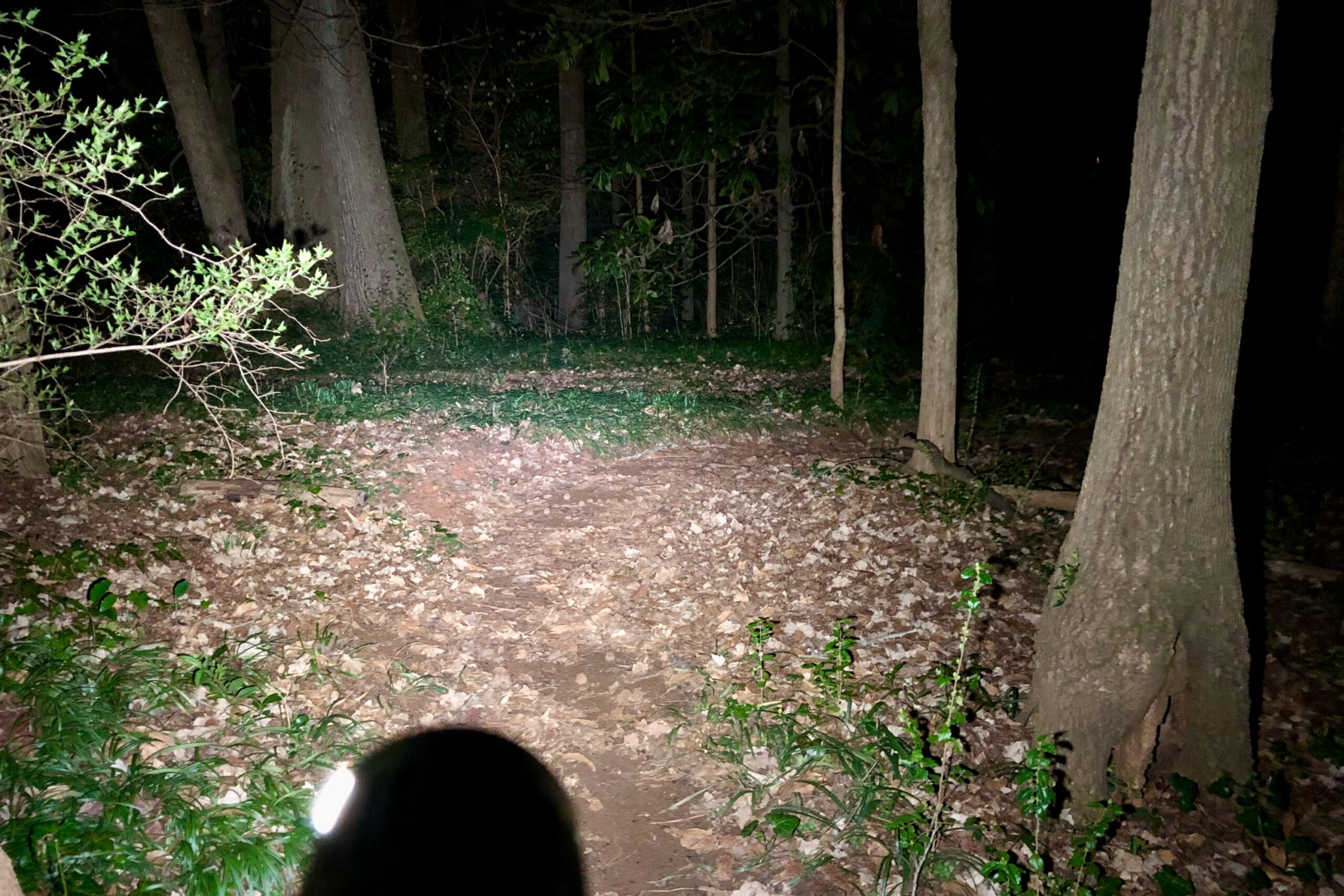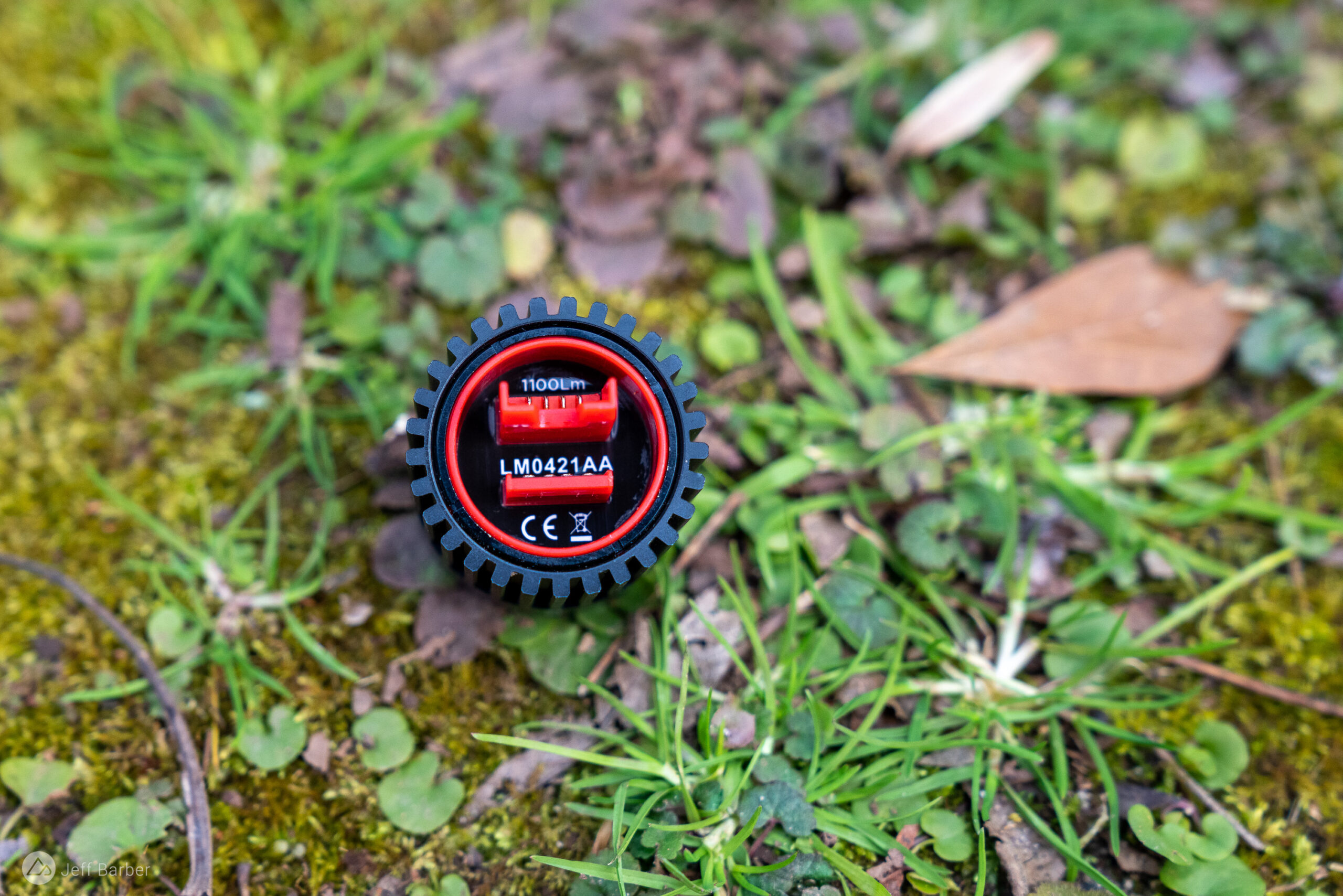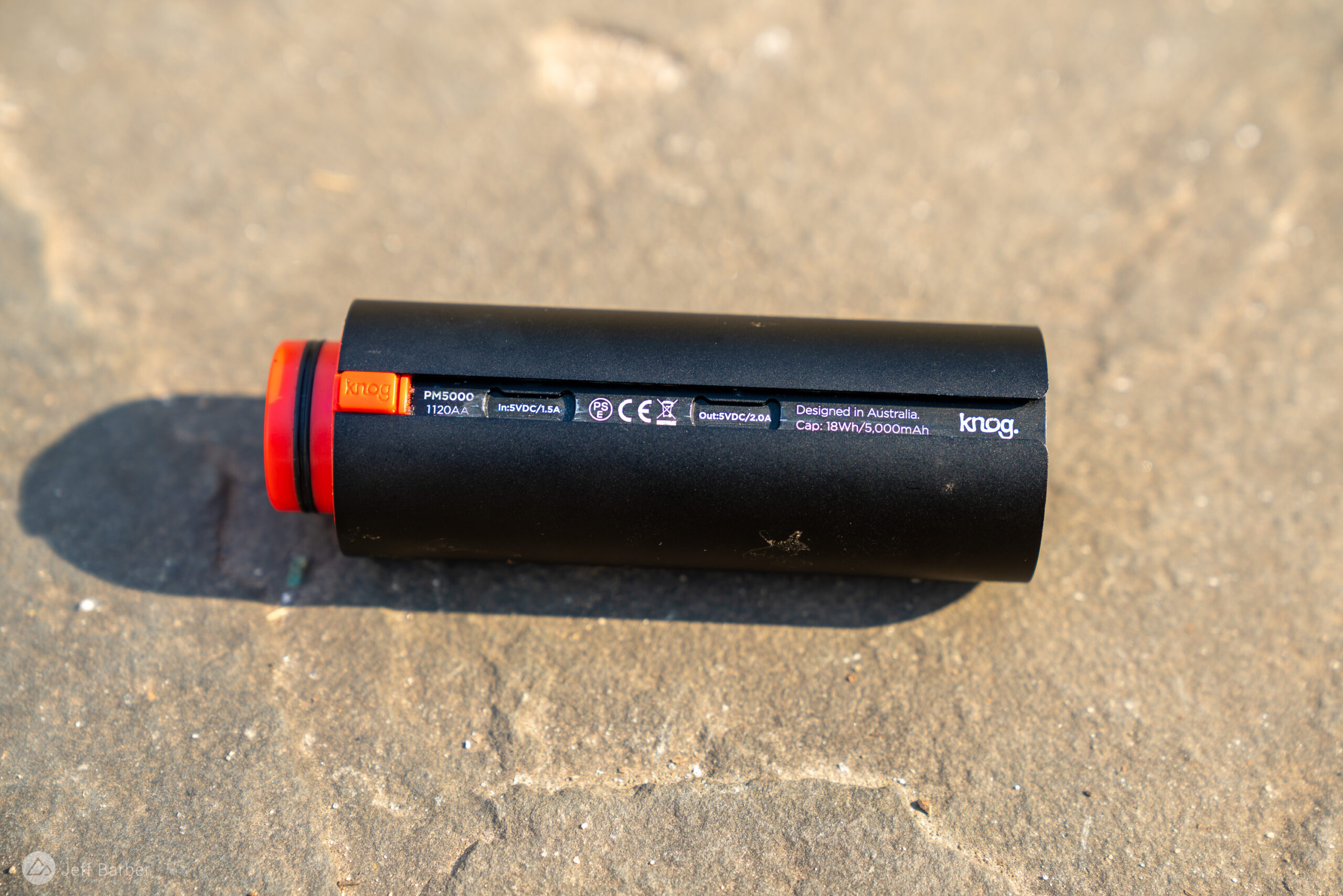
Reading the title, you’re probably thinking one of two things. It’s either clickbait because no bike light lasts forever, or it’s just hyperbole describing a light that seems to last a really long time. The Knog PWR Trail 1100 bike light ($119.95 at Amazon) does pack a big battery which allows it to last a long time and it’s part of a unique, modular system that includes a portable solar charger promising potentially endless days of off-the-grid power. There’s a lot to like about this bike light and the PWR system, though as usual I have a few nits to pick.

The Knog PWR Trail 1100 kit (tested) features an 1100lm headlight, a 5,000mAh power bank, and a handlebar mount designed to fit 31.8mm and smaller diameter bars. Like a lot of mountain bikers, I’m running 35mm bars so I needed to mount the light away from the center and toward the grip ends of the bars. Knog does offer a larger mount at an additional $21.95. Because the included mount is fairly tall, I wouldn’t recommend it for helmet mounting, especially if you ride forested trails at night. Knog makes a dedicated, corded helmet mount kit priced at $24.95 for getting the light off the bars.
Out of the box the light comes pre-programmed with six modes ranging from full, 1,100lm brightness down to “eco-flash” which is just 17lm. Using the free Modemaker software package it’s possible to add new light modes, remove ones you don’t need, or change the order of the modes. By default, there’s a big drop in brightness from mid-power (600lm) to low power (90lm) and unfortunately it’s not possible to adjust the brightness for the solid modes. However, I found the brightness for the “All On” mode can be adjusted as a workaround.


Twisting the light head toggles between brightness modes which is kinda fun and different, but also tends to be a bit awkward on the bike compared to a traditional push button. The beam pattern is dialed for night riding with a broad and fairly even distribution thanks to three separate LEDs and engineered lens.
Where the PWR Trail 1100 kit really shines is its battery life. The included battery is Knog’s mid-sized, 5,000mAh model, and it can be used to charge and power all kinds of devices from phones to bluetooth speakers. To put that battery capacity in perspective, it’s about twice what most bike lights of similar brightness offer. Because it’s such a big battery, Knog says a full charge takes about seven hours so planning ahead for night rides is a good idea. The battery input and output ports are accessed by removing the light head.



The runtime on medium power with the 1,100lm lamp is said to be 2.5 hours which seems like a conservative estimate based on my testing. Toggling between various brightness modes I got three, multi-hour night rides out of a single charge while bikepacking. For faster, more aggressive night rides where I used the brightest setting more often I found the battery easily lasts 4-6 hours. One hiccup is the battery life indicator doesn’t seem to be fully calibrated. On more than one occasion the red LEDs showed three out of four bars at the beginning of a ride, only to begin fading after just an hour or two when I had expected at least two to three hours more.
Altogether my PWR Trail 1100 kit weighs 245.8g; 171.3g for the battery, 53.7g for the light head, and 20.8g for the handlebar mount.


I also tested the PWR Headstrap ($32.95) which transforms the PWR Trail 1100 into a headlamp for camping, hiking, or trail running. It’s a nifty system that’s fairly comfortable and incredibly convenient for setting up camp in the dark. To save weight I decided not to take the 116g harness on a recent bikepacking trip, opting to save it for basecamp instead.

Now, about that everlasting power source. Knog recently added a rugged and foldable, 10W solar panel to the PWR line for charging a PWR bank or any other USB device like a phone or GPS. In ideal conditions the panels can deliver 10W of power which is more than most ‘fast’ smartphone chargers are even capable of slurping, so it’s definitely OP. The key caveat to that statement is ideal conditions; the time of day and the angle of the sun to the charging surface will determine how much power can be generated. Four LEDs indicate the level of charging which is helpful for finding the optimal charging location and position.
With just a single LED glowing (lowest charging level) on a mostly sunny February day I charged a Garmin Edge 530 from 25% to 100% in just over an hour. Charging the medium PWR battery from empty to full would likely take all the daylight hours on a sunny summer day, but in theory should be possible.
I also considered taking the PWR solar panel bikepacking but again decided against it due to the weight. The other issue is that while riding we tend to change direction a lot which requires adjusting the panels to directly face the sun for optimal charging. There’s a hook on one end to hang the panel from a backpack or tree branch, though I would like to see another hook at the other end to help stabilize the panel so it doesn’t flop around for riding. I think the ideal use case is to leave the panel at basecamp and charge the PWR battery during the day to prepare for nighttime shenanigans.
Lights, batteries, mounts, and other accessories in the PWR series (including a lantern and bluetooth speaker) can be purchased separately to dial in exactly what buyers need. For example, the large PWR Bank battery boasts double the capacity of the medium, and there’s a brighter, 2000lm light head as well. For most mountain bikers it probably makes sense to start with a kit like the PWR Trail I tested and add accessories over time.
Overall I really like the Knog PWR Trail light kit and the PWR modular system. The light head and battery together make for a light that’s just as good, if not better, than most standalone bike lights on the market, and the ability to reconfigure everything is a welcome bonus.
- Price: $119.95 for the PWR Trail 1100 kit. Additional accessories sold separately.
- Available at Amazon.
Party laps
- Long lasting battery
- Ideal beam pattern for night riding
- Cool form factor
- Many ways to customize and extend the system
Pros and cons of the Knog PWR Trail bike light system
Dirt naps
- Twist operation is a little awkward
- Included handlebar mount is limited
















